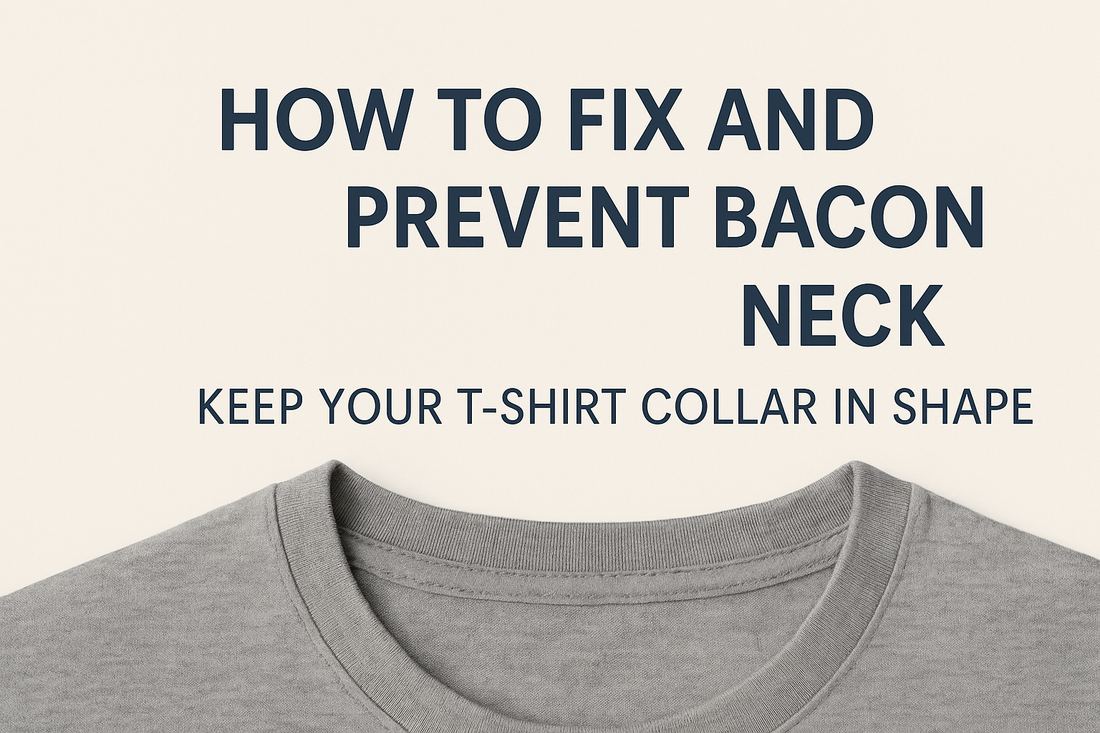
How to Fix and Prevent Bacon Neck: Keep Your T-Shirt Collar in Shape
Share
How to Prevent Your T-Shirt Neckline from Becoming Loose & Saggy - No More “Bacon Neck”
If you’ve ever pulled on your favorite graphic tee only to see the neck stretch out, droop, or go wavy like bacon, you’re not alone. Many tee lovers face the dreaded “bacon neck” — the saggy, flared, or baggy collar that ruins the clean look of a tee. In this post, we’ll dive into:
- Why necklines sag in t-shirts
- Prevention strategies and design “structure” you can add
- Repair / fixing methods (i.e. how to fix a bacon neck)
- Best practices (washing, storage, etc.)
- Related reading & product ideas
Let’s tighten that neck for good.
Why Necklines Sag (Understanding the Problem)
To prevent something, you must understand why it happens. Here are the main causes of saggy collars in t-shirts:
Fabric Fatigue & Loss of Recovery
- Over time, the knit fibers (especially in cotton or cotton blends) lose elasticity from repeated stretching, washing, and wearing.
- The “neckband” is a knit layer sewn onto the body; if it has no good recovery, it can’t spring back and flares outward.
- Low-quality ribbing or binding that’s too loose or too long relative to the opening will exacerbate sagging. Reddit users often note that many modern tees skip proper interfacing or structure.
-
Stretching During Wear & Removal
- Pulling the neck too wide when putting shirts on/off stresses the seam and the knit.
- Improper fit is a contributing factor too. If the shoulders or chest are tight, the collar takes extra stress when sliding over your head.
Improper Hangers or Storage
- Traditional wire or narrow hangers stretching the neckline.
- Improperly hanging wet or damp tees puts weight on the collar fabric, pulling it outwards.
- Overstuffed closets or stuffing the neck under tension.
Aggressive Washing & Drying
- Hot water, high-heat drying, and vigorous machine agitation degrade fiber integrity and accelerate sagging.
- Using harsh detergents may weaken the fibers.
Poor Construction / Lack of Internal Structure
- Many low-cost tees skip reinforcement (e.g. stay tapes, fusible interfacings, elastane ribs) for cost savings.
- If the binding strip isn’t cut shorter than the neck opening (i.e. built-in ease), the collar may have slack. Some sewists advocate cutting the binding shorter so it “pulls in” when sewn.
- No stabilizing tape or shoulder binding can allow the collar to shift outwards over time.
Because of these cumulative stresses, a once-slim collar becomes loose, curved, or flared — the dreaded saggy collar or bacon neck.
Prevention: Look for Structural Elements & Design Best Practices
If you're shopping for quality t-shirts or trying to curate a tee collection, here's what you should look for in terms of structure to avoid saggy collars from the start.
1. Quality Ribbing with Good Recovery
- Rib knit blends that include elastane/spandex (e.g. 5–10%) help the neckband retain shape.
- Use a slightly narrower rib (1×1 or 2×2) to provide more tension.
- Pre-shrink the rib before sewing so it doesn’t relax later.
2. Binding Length & Ease Engineering
- Cut the binding (neckband) shorter than the neckline by a modest percentage (e.g. 3–5%) so it’s under slight tension when sewn. This ensures the collar “pulls in” rather than flaring.
- Sew the binding into a closed loop before attaching, so stretch is evenly distributed.
3. Stay Tape / Fusible Stabilizer / Shoulder Tapes
- A narrow fusible knit tape sewn into the shoulder seams or neck seam helps stabilize the fabric and reduce stretch.
- Use a “stay tape” (nylon or twill) bridging the shoulder points to prevent shifting forces from reaching the neck.
4. Dual-Layer or Contour Collar
- A double-layer collar (e.g. folded over rib) gives extra strength.
- A contour neck (slightly curved band) helps distribute tension more evenly.
5. Use Better Fabrics / Blends with Stability
- Blends with polyester or modal often retain shape better than pure cotton.
- Heavy-weight jersey holds structure better than flimsy knits.
6. Allowing For Some Room
- Avoid overly tight necklines. A too-snug collar is under constant strain.
- Provide enough “give” in the neck opening so it doesn’t have to stretch excessively when worn. If you can't get it over your head comfortably, you need to go to a larger size.
At Whimspin, we're not about fast fashion. We want you to love our designs and be able to wear them for a long time. So, with that in mind we have chosen shirt blanks for our graphic tees that are designed to keep their shape and have a longer shelf life than something designed to be out of style next season. That means side seams, shoulder table, 1x1 ribbed collars that are folded for double thickness, pre-shrunken fabric, and over all good quality construction.
How to Fix a Bacon Neck in Existing Shirts
If your tee already has a saggy collar, don't toss it — you can salvage many with DIY fixes. Here are well-known techniques, from simple tweaks to more involved sewing:
Steam / Hot Water / Shrink Methods
- Steam method: Lightly steam the collar and then stretch it back into shape, letting it cool. Some sources suggest steaming helps relax fibers and “reset” shape.
- Hot water soak: Soak just the neckline (or whole shirt) in very hot water (careful — not boiling), then gently squeeze out excess and reshape the collar while damp, laying flat to dry. This may help the fibers shrink back slightly.
- Rubber band trick: (viral hack): Some people fold the collar in waves and soak in cold/ice water to reform its shape. Results vary.
- Hair dryer: Dampen the collar, then use a blow dryer to heat and gently mold it back.
These are quick, low-effort fixes, but may not last long for heavily stretched bands.
Sewing / Elastic Reinforcement
- Insert a narrow elastic: Open the back neck seam, thread a piece of lightweight elastic through the inside of the neckline, stitch it in place, and close the seam. This gives internal support.
- Re-stitch / tighten: Remove the collar, trim a little, and reattach it with slightly more ease (i.e. cut shorter) so it sits tauter. SewingJulie shows a video tutorial for removing and reapplying the original collar.
- Bias binding edge: After cutting a new neckline, finish it with a bias binding strip to give shape. This can work best for a t-shirt with
- Add interfacing / reinforcement patch: Sew a piece of stretchy knit interfacing behind the neckline area to give structure.
Tips & Cautions
- Always use thread that has a little stretch (poly or all-purpose) to avoid rigid seams that conflict with stretch.
- Go slow and let the machine feed the fabric — avoid stretching while sewing.
- Don’t overdo shrink methods; overheating can distort prints or damage fabric.
- Test on a less-favorite tee first.
Best Practices for Care & Storage to Help You Prevent Return of the Dreaded Bacon Neck
Even a well-built collar can sag if mistreated. You can get a full breakdown for proper laundry care for your tees at our blog post: How to Wash Graphic Tees – Essential Laundry Tips for Students Follow these practices to preserve your tees:
Washing & Drying
- Use cold water + gentle cycle: Reduces fiber stress.
- Turn shirts inside out: Minimizes abrasion on the collar.
- Use mesh laundry bags: for delicate tees.
- Avoid using high heat: If you must use a dryer, choose low or tumble-dry-air. Not only can high-heat damage, or shrink the fabric itself, but high heat will also damage the graphic in most cases.
- Go for drying flat: Lay the tee flat to dry to avoid pulling weight through the collar.
Storage & Hanging
- Folding over hanging: Folding t-shirts best preserves shape. But not everyone has enough shelves or room in the drawers for their t-shirts.
- Fold-over hang: Instead of hanging a tee from the collar, fold it (shoulder to shoulder) and drape over a bar to avoid stressing the neckline.
- Choose the right hanger: Use broad, contoured hangers - padded if possible. These distribute shoulder weight more evenly and reduce strain on the collar. The extra padding helps prevent sharp corner and the harder frames of most hangers from causing deformities in the fabric.
- Never hang wet: Always let shirts fully dry before hanging. The extra weight of the water will stretch the knit of the fabric and can cause it to lose its shape.
- Don't overcrowd: And over-crowed closet causes stress on our clothes and they push and pull on each other as your try to shove "just one more" thing onto the hanging rod. Leave breathing room so collars aren't smashed or pulled.
- Rotate your wardrobe: Don’t let one tee hang unused in tension for long. Leaving them hang for too long will have them fall victim to gravity over time, losing their shape and stretching. Besides, you are supposed to love wearing your clothes, and wear what you love!
Wearing & Removal
- Avoid pulling the neckline when putting on/taking off. Instead slide your arms through the sleeves and then pull it down or off.
- Choose tees with a little more ease in the chest/shoulders so the collar doesn’t stretch as much during wear. Just because you think a tighter tee makes you look better, doesn't mean that it's the correct fit! Save the tight clothes for spandex!
Keep Your Collar (and Confidence) in Shape
A great t-shirt isn’t just about the design on the front — it’s about how you feel when you pull it on. A crisp neckline frames your face, makes every outfit look intentional, and helps your favorite graphic tee feel like new, wear after wear.
Now that you know how to stop bacon neck before it starts (and how to fix it if it happens), you can keep every shirt in your rotation looking its best. Treat your tees with a little care — wash gently, skip the high heat, and store them folded or on the right hangers — and they’ll reward you with seasons of soft comfort and lasting structure.
At WhimSpin, we’re pretty serious about structure, too. Every one of our graphic tees is printed on premium Bella + Canvas blanks known for their resilient ribbed collars and long-lasting shape. Whether you’re rocking a witty quote, a literary reference, or a dinosaur on a surfboard, you shouldn’t have to worry about a saggy collar stealing the spotlight.
So go ahead — give your t-shirt drawer a quick check. Retire the floppy ones, refresh your favorites, and grab a few new designs that will keep their shape and your style intact.
Browse our latest collections here
